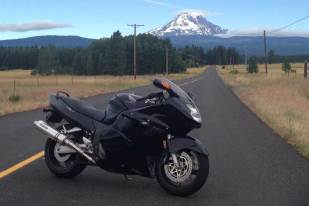What drives millions of Americans to abandon the comfy confines of safety-caged and airbag-filled four-wheeled conveyances to pilot unprotected, unstable, highly-powered fancied-up bicycles? That’s the question a new documentary on motorcycling, aptly titled Why We Ride, seeks to answer.
I took in the movie at the first annual (and sold out) Portland Motorcycle Film Festival, which also featured a screening of Peter Starr’s 1970s classic Take It To The Limit, nicely freshened up on Blu-ray and looking great on the big screen.
But it was Why We Ride (trailer here) that many of the festival-goers were waiting for and they were rewarded with a colorful composite of riding footage, amazing machinery and insightful interviews with motorcycle riders both famous and utterly ordinary.
Why make this film? People who ride motorcycles are still regarded as a bit of a strange lot – in the United States at least. Elsewhere on our small globe, no one really questions your sanity when you hit the starter button and ride your motorbike out into chaotic third-world traffic or at triple-digit speeds on the autobahn.
But here in the States, riding a motorcycle is still cause for concerned and often ignorant interrogation by parents, spouses, friends, cops and busybody strangers. I’ve been called suicidal, crazy, foolish, irresponsible, a leech on society and a bad father because I ride – and also allow my son to ride a little dirtbike. I’m not alone in this regard, obviously, which is why I and the rest of the sold-out crowd were happy to see a quality film like Why We Ride get made.
Industry icons like racing legend Kenny Roberts, riding guru Keith Code and customization icon Arlen Ness were familiar faces among the throng of interview subjects in Why We Ride, which also included the godfather of adventure riding, Ted Simon, author of the road trip epic Jupiter’s Travels.

The filmmakers also included interviews with a number of female riders, whether they were racers, veteran scoot jockeys or moms who just rolled with the kids on weekends. It is an overdue recognition of the many women riders in what is generally still regarded as a male-dominated activity.
Backed by swelling theatrical music, Why We Ride captures pretty much every facet of motorcycle riding in gorgeous detail. There are big-air dirt riders and open-road cruisers, hyped-out street machines and iconic classics, insane customs and speed demons ripping across the white wastes of the Bonneville Salt Flats at 200+ mph.
Iconic hallmarks of motorcycling, including a fascinating look at the evolution of the Daytona 200 race and the Sturgis rally, receive deserving details, as do some important early pioneers of the sport.
Our theater was filled with members of the target audience, as witnessed by the lineup of bikes in the parking lot and much hooting and applauding throughout the film. But the filmmakers also shot for the heart when they turned to happy families who ride together and war veterans who explained how they overcame crippling injuries and ruined lives in part by literally getting back in the saddle.
Perhaps the most resonant passage in the movie for this rider was when one of the interviewees explained how motorcycling is like a seed some people carry, and some people just don’t. Watered with exposure to motorcycles, riding becomes more than a hobby or interest, it essentially becomes religion, a church that participants attend by becoming involved, challenging themselves and working to master the aspects of an admittedly high-risk but highly rewarding activity.
Many riders in the film talked about being smitten with motorcycles from a very early age or from the time when they even first saw a motorcycle, any motorcycle. For me, that also rang true. The first time I saw a motorcycle as a child, I instinctively knew how it worked and wanted to ride. But my parents said hell no, so many years later, taking the chance to finally give it a go, I found those instincts proved correct. With the barest of instruction, I was off. Over 30 years later, I still feel the same thrill when I put the key in my bike. Why We Ride does as good a job of explaining that feeling as any motorcycle movie this side of the seminal On Any Sunday from 1971.
An old cliche’d quote you often see on helmet stickers or jacket patches is “if I have to explain it, you wouldn’t understand.” This is especially true with motorcycle riding, an activity that most people don’t casually take up like golf or knitting. For those of us for whom that seed has spread its roots in our souls and garages, the question of “why we ride” doesn’t really have a single simple answer, and the filmmakers wisely recognize this.
They touch on the camaraderie and equality between riders of all stripes, the challenges of finding mastery over a complex and unstable machine, the appreciation of the physics involved and the pride in knowing you can do something not everyone can do. It’s a calling, not a skill you can buy with lessons like a better tennis swing – although professional instruction certainly can improve the experience. It a desire that’s seemingly already present, and some people just don’t have it. These ideas are well served by Why We Ride.
But beyond those complicated answers, there is at least one reason to ride motorcycles the makers of Why We Ride and most everyone who does ride clearly agree on: it’s just a hell of a lot of fun.
You can watch Why We Ride on DVD and streaming services including iTunes, Amazon Instant Video, Xbox Video and Sony Entertainment Network.


